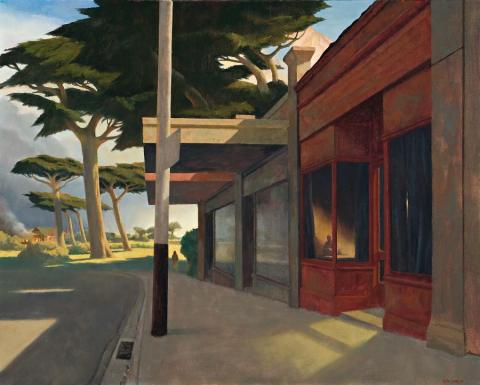AFTERNOON BY THE SEA, 2005
Rick Amor
oil on canvas
130.0 x 162.0 cm
signed and dated lower right: RICK AMOR ‘05
titled, dated and inscribed verso: Afternoon by the Sea / AUG / SEP / 05 / 130 x 162
Niagara Galleries, Melbourne (label attached verso)
Private collection, Melbourne
Evening by the Sea, 1998, oil on canvas, 81.0 x 116.0 cm, private collection
In Afternoon by the Sea, 2005, Rick Amor combines a technical brilliance with a mastery of moods in which his super-realist style is balanced by a powerful, underlying structure of form. The mood is invariably expectant, supported by nature through an atmosphere of spectral stillness and the dramatic interplay of lights and darks. This is continued in the man-made, with buildings dark and structures threatening; sculptured figures seem about to move, and people appear like sculptures, eerily frozen within the internal time span Amor gives to his paintings. Time has stopped in the artist's recollection of things past, and everything is caught in a web of silence.
From the late 1980s onwards, Amor began to explore memories of his past, of his youth at Frankston, the town and sea nearby. It began with the charcoal Study for Town by the Sea, 1989, and its companion oil, and continued in A Town by the Sea (Looking Back), each prefiguring our painting in the angled street scene, figures in shop windows, ubiquitous telegraph pole, and other details. In the following years, Amor painted a number of Frankston paintings which Gary Catalano has pointed out, 'cumulatively help to create a detailed picture of the Frankston in which he spent his childhood: the places of enchantment and fear are pictured in them, as are some of the personalities that, for whatever reason, loomed large in his imagination.'1 The theme and individual motifs continued to appear over the years. In Memory of a Guest House - Miss Prosser and the Albino, 1992, a figure looks through the long, parted curtains of a shop window. Evening by the Sea 1998 takes a darker, more distant view of the scene in our painting, complete with motionless figures and the calm before the storm forecast by red clouds. Cypresse (A Town by the Sea), 2005, is another variation on Amor's theme of loneliness and isolation. Afternoon by the Sea, 2005, presents a masterly summation of all these paintings, the previous deeper shadows of evening and night now giving way to those of day.
Richly biographical as these paintings are, Amor presents them with a paradoxically detached objectivity and engaged ambivalence, appearing occasionally, like Alfred Hitchcock, in his own production. As in A Town by the Sea (Looking Back) his observing presence is once again the illuminated figure looking out of the shop window, enriching further the painting's absorbingly enigmatic nature. Metaphors blend with narrative, a house mysteriously blazes in the background, and cypress trees reach upward, penitent, windswept, majestic. Amor's imagery is powerful as it moves between recollection and the unexpected.
1. Catalan, G., The Solitary Watcher: Rick Amor and his Art, Miegunyah Press, Melbourne University Press, 2001, p. 110
DAVID THOMAS
